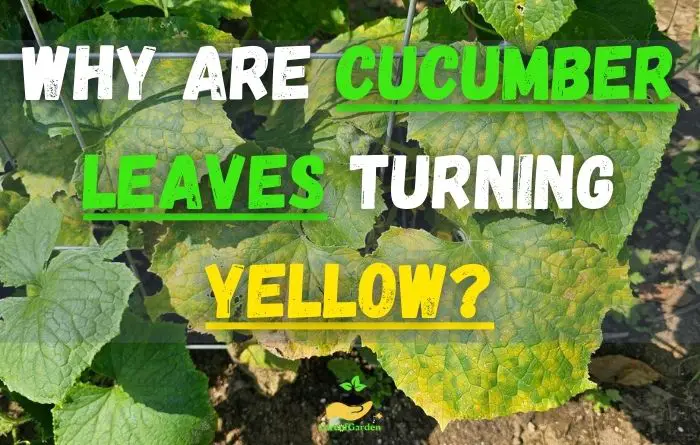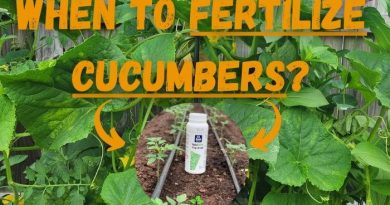[7 Reasons] Why Your Cucumber Leaves Are Turning Yellow!
Are you frustrated and confused about why your cucumber leaves are turning yellow? Don’t worry, you’re not alone. While it’s normal to be concerned about the health of your cucumbers, there are reasons why their leaves may turn yellow, and fortunately most of them can be easily addressed.
In this blog post, we’ll explore the most common reasons why cucumber leaves are turning yellow and what you can do to prevent it. So if you’re ready to get to the root of the problem and keep your cucumber plants healthy and vibrant, you’ve come to the right place!
Cause Why Cucumber Leaves Are Turning Yellow
| Cause | Symptoms on Cucumber Leaves | How to Identify |
|---|---|---|
| 1.Watering Issues | Leaves wilt and turn yellow | Check the soil moisture level and water the plant deeply if the soil is dry. |
| 2.Lack of light | Leaves turn yellow and may become spindly | Check the amount of light the plant is receiving and move it to a sunnier location if necessary. |
| 3.Nutrient deficiency | Yellowing starts on older leaves and moves up the plant | Perform a soil test to determine if there is a nutrient deficiency. |
| 4.Diseases | Leaves have yellow spots or lesions | Inspect cucumbers for signs of diseases such as downy mildew, fusarium wilt, or cucumber mosaic virus. |
| 5.Pests | Leaves have holes or yellow spots | Inspect the cucumbers for pests such as aphids, spider mites, and cucumber beetles. |
| 6.Environmental stress | Leaves turn yellow and curl | Check for environmental stressors such as high temperatures, low humidity, or exposure to chemicals. |
| 7.Natural Aging of the Cucumber Plant | Lower leaves turning yellow |
1.Watering Issues
One of the most common reasons for leaf yellowing in Cucumis sativus is a watering issue, namely a lack of water or overwatering.
Lack of Water or Inconsistent Watering
When cucumber plants don’t get water, they can experience a condition known as “water stress,” which causes their leaves to turn yellow.
This happens because when there’s a lack of water, the cucumber struggles to distribute nutrients and water to all parts of the plant including the leaves. As a result, the leaves start to wilt and change color.
In times of water stress, cucumber plants prioritize using their water for functions, like photosynthesis and growth. Consequently, there’s water left for essential tasks like maintaining leaf turgor pressure, which ultimately leads to yellowing leaves.
Treatment
I determine whether it is time to water cucumbers simply by dipping my finger into the soil near the roots of the plant. If, at a depth of 2-3 cm, I feel that the soil is dry, it is necessary to water it.
Watering: within a radius of 15-20 cm from the stem of the plant, but it is highly desirable to leave the ground dry a couple of centimeters near the root neck. This technique will protect cucumbers from fungal diseases.
The soil should be soaked to a depth of about 20 cm. Warm water (take it from a well or well and let it stand in the sun for two hours).
I recommend you to make the stream of water weak. I water with a watering can, from which I remove the nozzle. A very strong jet washes away the roots of cucumbers located in the upper layer of the soil.
Overwatering or Poor Soil Drainage
When cucumber plants are given excess water, their leaves can turn yellow due to a condition called “root rot.”
Excess water makes the soil saturated, preventing the roots from getting oxygen. This creates an environment where harmful bacteria and fungi thrive, attacking the roots and causing them to decay.
When cucumber plant roots are damaged or decaying, they can’t efficiently distribute water and nutrients to the rest of the plant. This deprivation of resources leads to yellowing and wilting leaves as they lack what they need to stay healthy.
Apart from root rot, overwatering can wash away nutrients from the soil, leading to deficiencies that manifest as yellow foliage.
Additionally, overwatering creates an environment that promotes diseases like powdery mildew, which causes leaf discoloration along, with other symptoms.
Treatment
To solve the problem of cucumber leaves turning yellow because of water you can try these solutions:
- Adjust the watering schedule: Let the soil dry out a bit between each time you water. Cucumber plants like to have soil. They don’t thrive in soggy conditions. Check the moisture level by sticking your finger about an inch, into the soil. If it feels wet hold off on watering until the top layer feels slightly dry.
- Use draining soil: Make sure that the soil you use for planting cucumbers drains well. Adding compost or perlite to the soil can help improve drainage and prevent water from pooling around the roots.
- Establish a watering routine: Create a watering schedule based on weather conditions and your cucumber plants specific needs. It’s best to water them in the morning to minimize moisture on the leaves during cooler nights.
2.Insufficient Light
Insufficient light can lead to the yellowing of cucumber leaves because plants rely on light to generate energy through photosynthesis. When a cucumber plant lacks light it struggles to produce enough energy to support healthy growth. This can manifest in symptoms, such as leaves turning yellow, stunted growth, and decreased yield.
For development, cucumber plants require a minimum of 6–8 hours of direct sunlight each day. If they don’t receive light, they may become weak and can also result in dropping of flowers or fruit.
In my experience, this is an issue that can occur when cultivating cucumbers either on a windowsill at home or in a garden. Insufficient lighting is often the culprit behind this problem, particularly when the chosen planting location isn’t ideal.
This usually happens during the early stages of cucumber growth. As the cucumber develops, some of the lower leaves within the soil bed may turn yellow and wither due to inadequate light exposure.
In a cucumber soil bed, they can grow into a dense thicket, hindering light from reaching the inner parts.
Consequently, older leaves, towards the bottom might not receive light and subsequently turn yellow. To address this matter simply pluck off the yellow leaves periodically and savor your bountiful harvest.
Treatment
To tackle the problem of cucumber leaves turning yellow due to insufficient light you can try the following solutions:
- Move the Cucumber Plants: If possible move the cucumber plants to an area in your garden or a spot that gets more direct sunlight. Look for a place that receives at 6 8 hours of sunlight daily.
- Utilize Reflective Materials: Position mirrors or white surfaces around the cucumber plants to redirect and amplify sunlight onto their leaves. This will optimize the light for photosynthesis.
- Trim Other Plants Nearby: Prune or remove any trees, shrubs or other plants close to your cucumber plants that may be causing shade. This will allow more sunlight to reach the leaves of your cucumbers.
- Consider Artificial Lighting: If you are growing cucumbers indoors or in a greenhouse think about supplementing sunlight with artificial grow lights. Specifically designed LED grow lights, for plants can provide the required light spectrum for growth.
3.Nutrient Deficiencies
Cucumbers need a lot of nutrients to grow and produce fruit. If there are not enough nutrients in the soil or substrate, then the leaves of the cucumbers begin to turn yellow.
Here are some of the most common nutrient deficiencies that can cause yellowing cucumber leaves:
- Nitrogen deficiency: When it comes to plant growth nitrogen is a nutrient that plays a crucial role. It’s responsible for the production of chlorophyll which gives leaves their green color. If there’s a shortage of nitrogen you may notice the leaves turning yellow or pale green.
- Phosphorus deficiency: Another important nutrient for plants is phosphorus. It’s essential for their growth and development. If theres not phosphorus available you might observe the leaves turning yellow and becoming stunted.
- Potassium deficiency: Maintaining plant health requires a supply of potassium. This nutrient is involved in processes like water regulation, photosynthesis and fruit development. A deficiency in potassium can cause the edges of the leaves to turn yellow or brown.
- Magnesium deficiency: Magnesium is another player in plant nutrition as it contributes to chlorophyll production and supports other vital processes within the plant. When magnesium levels are low you may see the leaves turning yellow or brown starting from the edges and moving inward.
- Iron deficiency: Iron also holds significance when it comes to chlorophyll production and other essential plant functions. Insufficient iron can result in white discoloration, on the leaves starting at the edges and spreading inward.
Treatment
| Nutrient Deficiency | Symptoms | Treatment |
|---|---|---|
| Nitrogen | Yellow or pale green leaves | Apply a nitrogen-rich fertilizer, such as blood meal or fish emulsion, to the soil around the plant. |
| Phosphorus | Yellow and stunted leaves | Apply a phosphorus-rich fertilizer, such as bone meal or rock phosphate, to the soil around the plant. |
| Potassium | Yellow or brown edges of leaves | Apply a potassium-rich fertilizer, such as wood ash or kelp meal, to the soil around the plant. |
| Magnesium | Yellow or brown leaves starting at edges and moving inward | Apply a magnesium-rich fertilizer, such as Epsom salt or dolomitic lime, to the soil around the plant. |
| Iron | Yellow or white leaves starting at edges and moving inward | Apply an iron-rich fertilizer, such as iron sulfate or chelated iron, to the soil around the plant. You can also apply foliar sprays of iron to the leaves. |
This year, like last year, I will use only fertilizer from weeds and wood ashes to feed the cucumbers. Infusion of weeds is a nitrogen fertilizer, and an ash solution is necessary for cucumbers during flowering and ovary formation.
Because if the leaves of cucumbers turn yellow, there may be a deficiency of potassium in the nutrition of cucumbers.
4.Diseases
Downy Mildew (Peronospora cubensis)
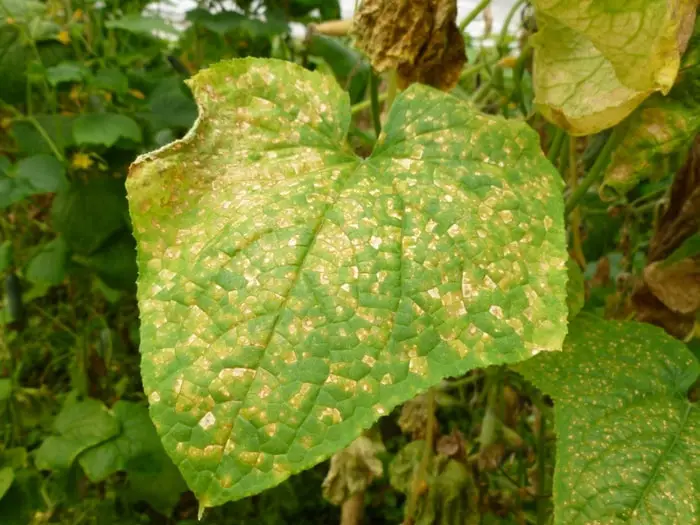
Of all cucumber diseases, this is one of the most common. It affects the leaves of the cucumber, causing the formation of dark yellow spots on the upper side while a brown mold forms on the lower one in correspondence with the spots.
As the disease progresses, the leaves may dry out and fall off. It is a disease very similar to that of grapevines, but the fungus responsible, Pseudoperonospora cubensis , is part of a different species.
| Cucumber Varieties Resistant to Downy Mildew |
|---|
| Tasty Green |
| Sweet Success |
| Dasher II |
| Diva |
| Raider |
| Fanfare |
| Salad Bush |
Treatment
To tackle the problem of cucumber leaves turning yellow due to Downy mildew, try these solutions:
- Buy Resistant Varieties: Choose cucumber varieties that have been specifically bred to resist Downy Mildew. These plants are better equipped to handle the disease. May exhibit milder symptoms if they become infected.
- Use a Drip Irrigation System: Water your cucumber plants at the soil level using drip irrigation or soaker hoses. Avoid watering as it can create moisture on the foliage, which encourages the spread of Downy Mildew spores.
- Remove Affected Leaves: soon as you notice signs of Downy Mildew promptly remove and dispose of any affected leaves to prevent spreading of the disease. Do not include infected plant material in your compost pile.
- Use Fungicidal Sprays: Apply fungicides specifically designed for controlling Downy Mildew either at the indication of the disease. Always follow the instructions and safety precautions mentioned on the product label.
- Consider Organic Fungicides: If you prefer an eco approach you might want to explore fungicides that contain ingredients, like copper or potassium bicarbonate which can help manage Downy Mildew effectively while being more environmentally conscious.
Fusarium Wilt (Fusarium oxysporum f. sp. cucumerinum)
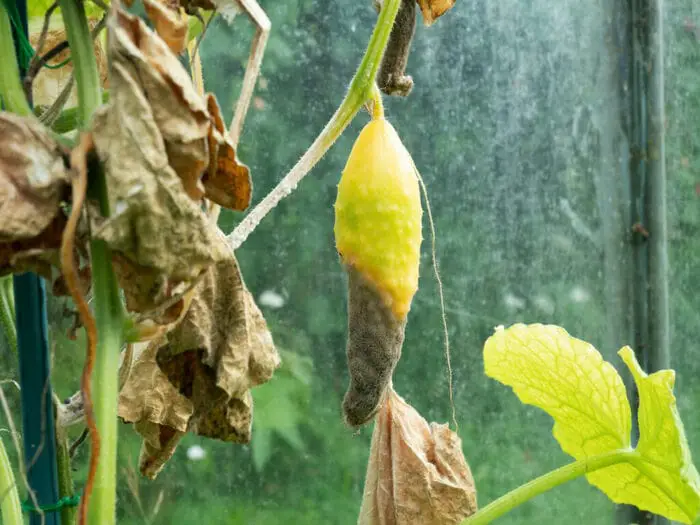
Fusarium wilt is a type of infection that can affect cucumber plants, causing their leaves to change color to yellow.
This fungus first attacks your cucumber roots, then spreads throughout its vascular system, obstructing the flow of water and nutrients to different parts of the cucumber including the leaves.
As the disease progresses, you may observe wilted and faded leaves. Interestingly, this yellowing tends to be more noticeable during daylight hours but might appear to recover in the dark.
Unfortunately, over time many cucumber plant die due to this disease while others simply exhibit poor growth and produce limited flowers or fruits.
Treatment
Fusarium wilt is a contagious and tenacious disease that can persist in the soil for years, making it difficult to control.
The best way to prevent Fusarium wilt is to plant disease-resistant cucumber varieties and to practice good sanitation, such as removing and destroying infected plants and avoiding planting cucumbers in the same location for several years.
| Cucumber Varieties Resistant to Fusarium Wilt |
|---|
| Diva |
| Marketmore 76 |
| Sweet Success |
| Dasher II |
| Indy |
| Straight Eight |
| Intimidator |
| Suyo Long |
Cucumber Mosaic Virus
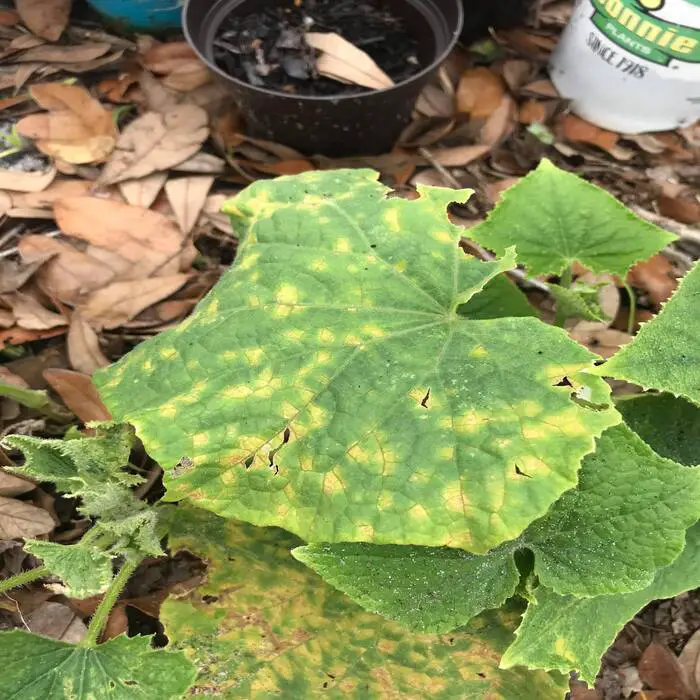
The Cucumber Mosaic Virus (CMV) is a plant virus that can lead to the yellowing of cucumber leaves. When cucumber plants get infected with CMV the virus hinders their ability to produce chlorophyll, which is responsible for the color necessary for photosynthesis. Consequently, the affected cucumber leaves lose their color and turn yellow.
Aphids primarily transmit CMV by feeding on infected plants and then spreading the virus to ones as they move from one plant to another. Once inside a cucumber plant the virus multiplies and spreads throughout its system, disrupting the movement of water and nutrients.
Over time, the affected leaves become deformed, displaying wrinkles and blisters between the veins. This disease tends to thrive in the presence of aphid species such as Aphis gossypii and Myzus persicae.
In advanced stages of infestation warts may develop on the fruits skin leading to improper maturation.
To prevent the spread of the virus and safeguard your plant’s health, it is essential to take measures such as removing aphids, along with any yellowed leaves or infected fruits, from the cucumber plant.
The severity of these symptoms can differ based on factors such as cucumber variety, environmental conditions and stage of infection. In some cases, there might be a recovery in the affected cucumber plants condition; however, their overall health and productivity are compromised.
Treatment
The only way to fight against the cucumber mosaic virus is indirectly, by controlling aphids and eliminating infected plants with fire. It’s also important to dispose of neighboring plants, such as cucurbits or tomato plants, as the virus can spread quickly and lead to complete crop failure.
Since the virus is transmitted by aphids, it’s important to remove them, as well as the yellowed leaves and infected fruits of the cucumber plant.
However, you should never compost the plant parts, as this could allow viruses and fungi to spread again in the garden. Instead, the residual waste is better suited for disposal.
5.Pests
Aphids
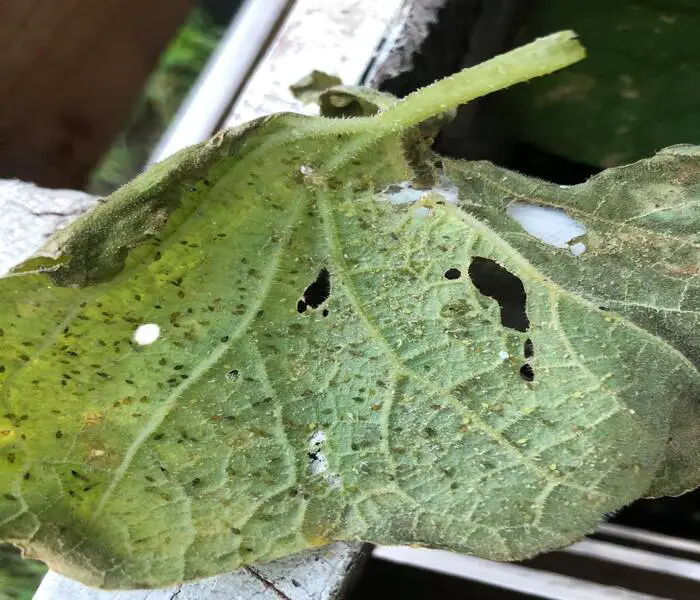
As described above, aphids are the cause of the cucumber mosaic virus. The pests are often found in larger colonies on the cucumber plants and can cause yellow leaves even without the transmission of the cucumber mosaic virus.
Aphids can appear suddenly on your Cucumis sativus plants, making them a dangerous pest. In contrast to other pests, care errors are not the only reason for colonization.
When aphids feed on cucumber plants, they not only take away important nutrients but also inject their saliva into the plant’s tissues. This saliva contains toxins that can harm the cells of the leaves and interfere with the cucumber ability to carry out vital functions like photosynthesis.
The damage caused by aphid feeding disrupts the movement of nutrients and water within the cucumber plant.
As a result, the affected leaves begin to show signs of yellowing. The yellowing usually starts near where the aphids have been feeding but may spread to other parts of the plant if there are a lot of aphids present.
Treatment
To prevent aphids from infesting cucumber plants and causing leaf yellowing you can do this:
- Physical Removal: Use a stream of water or a gentle brush to manually remove aphids from the cucumber leaves.
- Neem Oil or Insecticidal Soap: Apply neem oil or insecticidal soap to the leaves as they are effective in controlling aphids without causing harm to insects.
- Natural Predators: Introduce predators like ladybugs, lacewings and parasitic wasps into your garden. They can help maintain a population of aphids.
- Companion Planting: Plant aromatic herbs such as mint, basil or cilantro near your cucumber plants. The strong scents emitted by these herbs act as repellents, for aphids.
Spider Mites
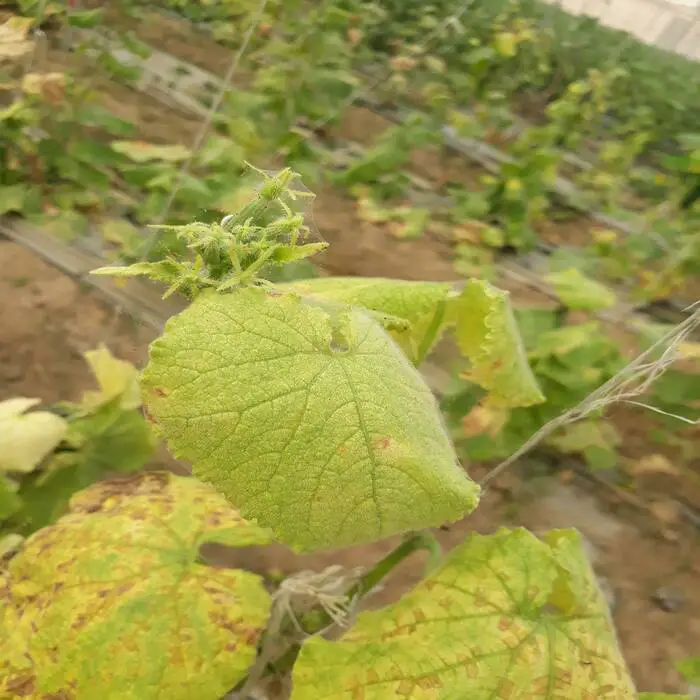
Spider mites are these pests that can make cucumber leaves turn yellow through their feeding activities.
They like to munch on the undersides of the leaves causing harm to the cucumber plant cells and making it harder for them to do photosynthesis. This harm can then lead to the leaves turning yellow, then brown, and eventually killing the cucumber plant.
You usually find spider mites in dry conditions. If you don’t keep an eye on them, their populations can skyrocket pretty quickly. They’re not easy to spot with your eyes. You can tell they’re around by noticing the delicate webbing they create on the undersides of leaves.
Treatment
To manage spider mite infestations and prevent cucumber leaves from turning yellow:
- Spray with Water: Give the leaves a rinse with a powerful stream of water to wash away spider mites. This can help reduce their numbers and prevent damage.
- Try Neem Oil or Insecticidal Soap: Apply neem oil or insecticidal soap to the leaves as they are effective in controlling spider mites without causing harm to beneficial insects.
- Bring in Predatory Mites: Introduce predatory mites, like Phytoseiulus persimilis, which feed on spider mites and help maintain their population at a level.
Cucumber Beetle
Cucumber beetles, both the spotted types, are pests that can make cucumber leaves turn yellow. When they feed, they create holes and scars on the leaves, which causes damage and hampers the process of photosynthesis.
One of the ways cucumber beetles contribute to yellowing is by transmitting wilt. As they feed on the plant they introduce bacteria from their gut into their system. This blocks the flow of water and nutrients, leading to wilting and yellowing of the leaves.
Aside from wilting, cucumber beetles can also induce yellowing by feeding on the leaves and causing physical harm. This weakens the cucumber and makes its leaves more susceptible to diseases, resulting in yellowing and wilting.
| Crop Rotation Plan to Prevent Cucumber Beetles | Description |
|---|---|
| Season 1 | Plant Cucumbers |
| Season 2 | Plant Non-Cucurbit Crops (e.g., Beans, Lettuce, Spinach) |
| Season 3 | Plant Cucumbers |
| Season 4 | Plant Non-Cucurbit Crops (e.g., Tomatoes, Peppers, Carrots) |
| Season 5 | Plant Cucumbers |
| Season 6 | Plant Non-Cucurbit Crops (e.g., Broccoli, Cabbage, Radish) |
| Season 7 | Plant Cucumbers |
| Season 8 | Plant Non-Cucurbit Crops (e.g., Corn, Cauliflower, Beets) |
| Season 9 | Plant Cucumbers |
| Season 10 | Plant Non-Cucurbit Crops (e.g., Potatoes, Onions, Swiss Chard) |
| Repeat the Cycle | Continue rotating Cucumbers with Non-Cucurbit Crops, avoiding planting cucumbers in the same location for consecutive years. |
Treatment
Here are some effective techniques, for managing infestations of cucumber beetles:
- Covering the Rows: You can use floating row covers to shield cucumber plants from beetle infestations. These covers act as a barrier preventing beetles from reaching the plants while still allowing sunlight and water to pass through.
- Manual Removal: Regularly inspect your cucumber plants for cucumber beetles. Remove them manually. Simply pick them off. Drop them into a bucket of water to prevent them from returning to the plants.
- Natural Predators: Introducing predators of cucumber beetles, such as wasps and beneficial nematodes into your garden can help keep the beetle population under control.
- Crop Rotation: Practice crop rotation by avoiding planting cucurbits (cucumber, squash, melon) in the spot for growing seasons. This helps reduce the buildup of cucumber beetles in that area.
- Trap Crops: Planting trap crops like radishes or nasturtiums near your cucumber plants can attract cucumber beetles away from your crop. This strategy can provide protection, for your cucumbers by diverting the attention of these pests.
- Diatomaceous Earth: You can sprinkle your cucumbers with diatomaceous earth. This natural substance contains particles that’re abrasive and can puncture the beetles outer shell causing them to dehydrate and eventually die.
6.Environmental Stress (Sunburn, Cold)
Sunburn
Small areas of yellowing with clear contours on cucumber leaves can be due to sunburn, especially if the cucumber was watered the day before and it was sunny. This is not harmful to the plant, but it’s best to avoid watering during periods of high solar activity.
Yellow-orange spots on the leaves can also be due to the scorching sun, especially if water droplets are present. To prevent this, water and spray cucumbers in the morning or evening and regularly ventilate greenhouses to prevent condensation.
Treatment
Here are some steps you can take to treat sunburn, in cucumber plants:
- Provide Shade: If possible give your cucumber plants shade during the part of the day. You can use shade cloths or taller neighboring plants to create shade.
- Watering: Make sure to adequately water your cucumber plants during hot and sunny periods. Proper watering will keep the plants hydrated. Help reduce the severity of sunburn.
- Time of Watering: Water your cucumber plants either early in the morning or late, in the afternoon to minimize leaf wetness during peak sunlight hours.
- Mulching: Apply a layer of mulch around your cucumber plants to retain soil moisture and regulate soil temperature. Mulch acts as a barrier preventing the soil from overheating and reducing the risk of sunburn.
Cold Temperatures
When the temperature drop significantly, for cucumber growth the plants metabolism slows down making it harder for it to absorb and use nutrients. As a result the leaves may start turning yellow.
Furthermore cold temperatures can cause water stress, in cucumber plants since the roots struggle to absorb water when the soil temperature drops. This can lead to wilting and yellowing of the leaves.
In situations low temperatures can even harm the plants cell membranes causing cell death and resulting in yellowing of the leaves.
Treatment
To prevent cold-induced yellowing of cucumber leaves:
- Protective Measures: Cover cucumber plants with row covers, cloths, or plastic sheets during cold spells to shield them from excessively low temperatures.
- Avoid Planting Too Early: Plant cucumber seeds or transplants outdoors after the last expected frost date in your area to reduce the risk of exposure to cold temperatures.
- Choose Resistant Varieties: Select cucumber varieties that are more tolerant of cooler temperatures.
7.Natural Aging of the Cucumber
Yellowing of the lower leaves in cucumbers near the end of the season may be due to natural aging.
Cucumber leaves age from the bottom up, as they are the first to grow. It is normal for the lower leaves to die off as the plant directs energy towards new shoots, flowering, and fruiting. To prevent rotting, it is best to remove the yellow leaves promptly.
As cucumbers grow, metabolic processes slow down in the older leaves, leading to yellowing and eventual death. The lower leaves may not receive sufficient nutrients as your cucumbers prioritize new leaf growth.
If yellowing occurs at the roots in summer, it indicates that those leaves have served their purpose and should be promptly removed to prevent fungal diseases.
Aging of cucumber leaves can be hastened by excessive leaf fertilization. While this may happen, it is likely that by the time most leaves age, you’ve already harvested enough cucumbers. If you desire fresh cucumbers until autumn, methods to extend the life of cucumber vines can be used.
How to Prevent Cucumber Leaves From Turning Yellow
| Prevention Methods | Description |
|---|---|
| Choose Resistant Varieties | Select cucumber varieties that are resistant to common diseases and pests, reducing the risk of yellowing. |
| Practice Crop Rotation | Rotate cucumber crops with non-related plants to prevent the buildup of diseases in the soil. |
| Proper Plant Spacing | Plant cucumbers with adequate spacing to improve air circulation and reduce humidity, preventing diseases. |
| Monitor and Control Pests | Regularly inspect plants for pests like aphids, spider mites, and cucumber beetles. Control their population to minimize stress on the plant. |
| Provide Sufficient Water | Ensure cucumbers receive consistent and adequate watering, avoiding both underwatering and overwatering. |
| Apply Mulch | Mulch around cucumber plants to conserve soil moisture, maintain even temperatures, and reduce stress. |
| Use Drip Irrigation | Utilize drip irrigation or soaker hoses to water cucumbers at the root zone, minimizing foliar wetness. |
| Use Proper Fertilization | Apply balanced fertilizers in appropriate amounts to provide essential nutrients without causing excess growth. |
| Introduce Beneficial Insects | Attract or introduce beneficial insects like ladybugs and lacewings to control pests naturally. |
| Promote Garden Hygiene | Keep the garden clean and free from debris, promptly removing any diseased plant material. |
| Monitor and Adjust Environmental Conditions | Regularly check for changes in temperature, light, and humidity that may affect cucumber health. |
| Use Protective Covers | Employ floating row covers to protect young cucumber plants from pests and harsh weather conditions. |
| Monitor and Act Early | Regularly inspect cucumber plants for any signs of distress and address issues promptly to prevent yellowing. |
Should I cut off yellow cucumber leaves?
Yes, if the yellowing is due to old age, it’s generally safe to remove the yellow leaves to prevent them from rotting on the plant and potentially causing fungal diseases.
However, if the yellowing is due to a pest infestation or disease, it’s important to identify and treat the underlying issue rather than simply removing the affected leaves.
Removing the leaves in this case may not solve the problem and could actually make it worse by promoting the spread of the pest or disease.
Frequently Asked Questions
Cucumber leaves can turn yellow due to a variety of reasons, including pests, diseases, environmental factors such as temperature and water, and nutrient deficiencies.
Yellowing of cucumber leaves due to a pest or disease issue may be accompanied by other symptoms such as spots, lesions, or wilting. It’s important to identify the specific symptoms and take appropriate action, such as using insecticides or fungicides, to address the underlying problem.
Yes, yellowing of cucumber leaves can be prevented by taking steps to maintain the health of your plants. This includes providing adequate water, proper nutrition, good air circulation, pest control, and disease prevention.
If your cucumbers are turning yellow before they grow, it could be due to a variety of reasons. One possible cause is poor pollination. If the flowers on the cucumber plant are not properly pollinated, the resulting fruit may be small and yellow instead of growing into a full-sized cucumber.

